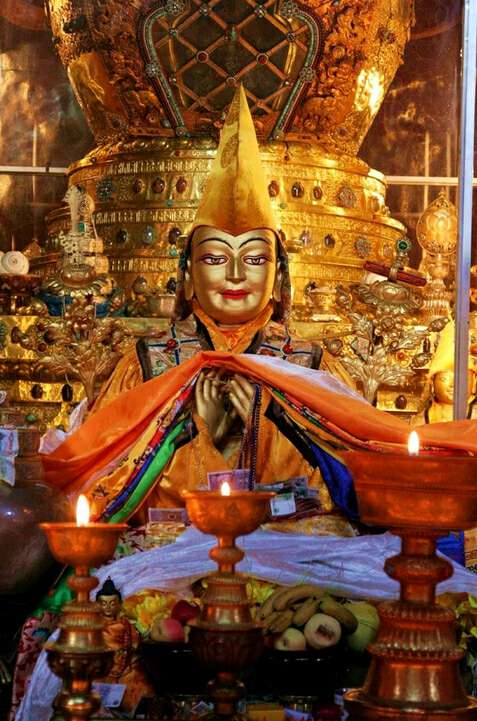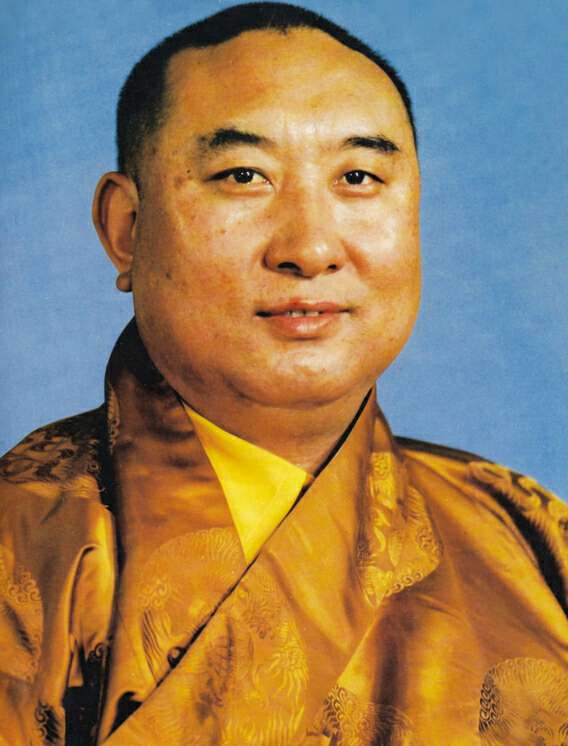Gelugpa
Tsongka pa life story (1357-1419)
 Tsongkapa was born in Tsongka, Amdo, in 1357, the fourth of six sons. The day after Tsongkapa’s birth, Chojey Dondrub Rinchen sent his main disciple to the parents with gifts, a statue, and a letter. A sandalwood tree grew from the spot where his umbilical cord fell to the ground. Each leaf had a natural picture of the Buddha Sinhanada, and was thus called Kumbum, a hundred thousand body images. The Gelug monastery called Kumbum was later built on that spot.
Tsongkapa was born in Tsongka, Amdo, in 1357, the fourth of six sons. The day after Tsongkapa’s birth, Chojey Dondrub Rinchen sent his main disciple to the parents with gifts, a statue, and a letter. A sandalwood tree grew from the spot where his umbilical cord fell to the ground. Each leaf had a natural picture of the Buddha Sinhanada, and was thus called Kumbum, a hundred thousand body images. The Gelug monastery called Kumbum was later built on that spot.
Tsongkapa was not like an ordinary child. He never misbehaved; he instinctively engaged in bodhisattva type actions; and he was extremely intelligent and always wanted to learn everything. At the age of three, he took lay vows from the Fourth Karmapa, Rolpay Dorjey(1340-1383). Soon after, his father invited Chojey Dondrub Rinchen to their home. The lama offered to care for the education of the boy and the father happily agreed. The boy stayed at home until he was seven, studying with Chojey Dondrub Rinchen. Just seeing the lama read, he instinctively knew how to read without needing to be taught.
During this time, Chojey Dondrub Rinchen gave the boy the empowerments of Five-Deity Chakrasamvara, Hevajra, Yamantaka, and Vajrapani. By the age of seven, he had already memorized their complete rituals, had completed the Chakrasamvara retreat, was already doing the self-initiation, and already had a vision of Vajrapani. He frequently dreamt of Atisha (982-1054), which was a sign that he would correct misunderstandings of the Dharma in Tibet and restore its purity, combining sutra and tantra, as Atisha had done.
At the age of seven, Tsongkapa received novice vows from Chojey Dondrub Rinchen and the ordination name Lozang Dragpa. He continued to study in Amdo with this lama until he was sixteen, at which time he went to U-tsang (Central Tibet) to study further. He never returned to his homeland. Chojey Dondrub Rinchen remained in Amdo, where he founded Jakyung Monasery (Bya-khyung dGon-pa) to the south of Kumbum.
At the age of 40, and as probably the most learned man of his era, Tsongkapa joined the Kadam monastery of Rating. Here, in 1402, Tsongkapa completed his magnum opus, The Great Graduated Path (lam.rim.chen.mo), which was principally based on Atiśa’s Bodhipathapradīpa, and has become the root text of the Gelug school. As elsewhere in his voluminous writings, Tsongkapa emphasizes Prāsaṅgīka-madhyāmaka as the highest form of reasoning and stresses the correct understanding of relative reality as that which, while not possessing even a conventional own-being, can nevertheless be demonstrated by reasoning to be not non-existent. At the heart of The Great Graduated Path is the thesis that, while tantra may be necessary in order to become a fully enlightened Buddha, a prior study of sūtra is absolutely necessary for a preliminary development of wisdom and compassion. In another important work, The Great Graduated Path of Mantra, which discusses the four classes of tantra, Tsong Khapa defines the relationship of tantra to sūtra as that between method and wisdom.
In 1408, Tsongkapa established the Great Prayer (Mon.lam.chen.mo), a New Year festival held in the Jokhang, which won him much devotional support. In 1409, Tsongkapa had enough followers to found his own monastery of Riwo Ganden, and although initially calling his order the ‘New Kadam’, they soon became known as the Gelug. Tsongkapa’s views were similar to those of Atiśa, and it is unclear whether Tsongkapa had reformed a Kadam tradition which had become lax, or whether the Gelug simply grew out of the Kadam under the impetus of his own personal renown. The founding of Drepung followed in 1416, and of Sera in 1419, the year of Tsong Khapa’s death when his body was embalmed and placed inside a chörten(tomb stupa) at Ganden.
Gelug
 The Gelugs (yellow hats) tradition was founded by Tibetan teacher Je Tsongkhapa (1357-1419). The basis is formed by the old Kadam lineage, but it in fact includes all other Tibetan traditions. For example; Tsongkhapa’s main teacher was the Sakya teacher Rendawa.
The Gelugs (yellow hats) tradition was founded by Tibetan teacher Je Tsongkhapa (1357-1419). The basis is formed by the old Kadam lineage, but it in fact includes all other Tibetan traditions. For example; Tsongkhapa’s main teacher was the Sakya teacher Rendawa.
Sonam Gyatso (1543-1588), received the title ‘Dalai Lama’ (Ocean of Wisdom) from the Mongol ruler Althan Khan in 1578. In 1642, the 5th. Dalai Lama became temporal and spiritual leader of Tibet by order of the Mongol ruler Gushri Khan. Although trained in all four schools, basically all Dalai Lamas were Gelug; one of the reasons that Gelug tradition is most widespread in Tibet. Note that the posthumously declared “First Dalai Lama” named Gedun Drupa (born 1391) was a disciple of Je Tsongkhapa.
Unlike what many people think, the Dalai Lamas are not the spiritual heads of the Gelugpa school; this is always the Gaden Tripa. Some typical aspects of the Gelug tradition: emphasis on ethics and sound scholarship. Main Buddhist teachings are collected in the Lamrim presentation (not unlike the Lamdrey teachings of the Sakya). The Gelug introduced a scholarly title “Geshe” for a fully qualified and authoritative spiritual master.
Ganden Tripa is the spiritual title for the head of the Gelugpa, not the Dalai Lama as in often misunderstood, Ganden Tripa is neither reincarnation nor heritable, it is appointed on the basis of some competitive examinations among the candidates, and duration of the position is 7 year term. The recent one is the 102th Ganden Tripa Thupten Nyima Lungthok Tenzin Norbu.
